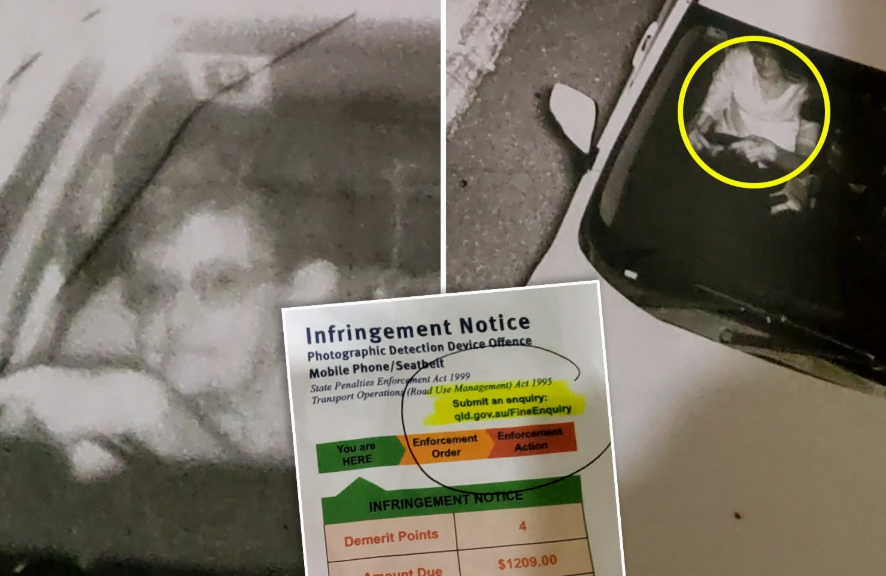
The letter arrived like a slap in the face.
A 79-year-old cancer survivor from Townsville opened it, only to find a $1,209 fine for ‘incorrectly’ wearing her seatbelt.
What made it worse—she had a doctor’s certificate proving she had no choice in the matter.
For Jennifer Howard, a seatbelt worn the standard way wasn’t just uncomfortable—it was dangerous.
After losing her voice box to cancer, her throat surgery left her unable to have anything press against her neck.
A normal seatbelt could block her only remaining airway if an accident occurred.
‘She can’t wear necklaces or anything because it inhibits her breathing,’ explained her husband Richard, 82. ‘If anything were to happen, like an accident, and the seatbelt were around her neck, it would stop her breathing entirely.’
When the system gets it wrong
In Queensland, medical exemptions for seatbelt use must be issued by a registered Australian doctor on form F2690 and renewed every 12 months.
Jennifer had done everything right.
What she didn’t have was protection from the state’s automated camera system.
A roadside camera on Thuringowa Drive captured her wearing her seatbelt under her arm in May, automatically triggering a fine.
The camera couldn’t tell the difference between someone flouting the law and a cancer survivor following her doctor’s orders.
'We got this bloody yellow box thing on the side of the road where they take the photo. Obviously, it came up that Jen had it under her arm, and we got a fine.'
For people with legitimate medical exemptions, the reality is harsh.
The system automatically issues fines, forcing them to appeal every time—no matter how valid their exemption is.
It’s a process that assumes guilt first and requires vulnerable drivers to prove their innocence repeatedly.
The bureaucratic maze
The following months were a nightmare of back-and-forth paperwork.
Queensland transport authorities admit exemptions are granted only in ‘extremely rare circumstances,’ which made Jennifer’s situation even more frustrating.
‘We’re not really computer literate. I had to get my friend down the road to do all the emails and everything to these people,’ Richard said.
As they struggled through the online appeals process, the fine ballooned to $1,289.85 due to late payment fees.
A widespread problem
Registration of exemption certificates is supposed to stop repeat fines—but only if the certificate is uploaded correctly to the digital system.
Jennifer’s wasn’t, and that simple technical mistake cost her dearly.
Medical seatbelt exemptions in Australia
Valid across all states and territories
Must be signed by a registered Australian doctor
Maximum validity: 12 months
Extremely rare—granted only when seatbelt use poses greater risk than benefit
Common qualifying conditions: certain spinal injuries, recent chest/abdominal surgery, specific breathing conditions
Digital registration required to avoid automatic camera fines
The Queensland Revenue Office has stated that they ‘do not issue camera-detected seatbelt infringement notices where a person has lodged a valid Seatbelt Exemption Certificate.’
The problem lies in that single word—‘lodged.’
It must be done in the right format, through the right digital channel, and renewed on time every year.
The human cost of automated enforcement
Richard suspected the system was designed to make people give up.
‘I can understand so many young people who don’t have the time, and it’s all just too hard to try and go through, that they’d end up just saying, I’ll pay the bloody fine and get on with my life.’
For pensioners like the Howards, a $1,200 fine was a major financial blow.
Combined with the stress of navigating complex bureaucracy while managing serious health issues, it was almost too much to bear.
What seniors with medical exemptions should know
- Ensure your certificate is digitally registered with your state's transport authority
- Set calendar reminders for annual renewals
- Keep physical copies in your car at all times
- Don't pay fines immediately—appeal with your medical documentation
- Seek help from family or friends for online appeals processes
- Contact seniors' advocacy groups if you're struggling with the system
A system in need of repair
After months of stress, Jennifer’s fine was finally withdrawn.
But her ordeal exposed a critical flaw in Australia’s automated traffic enforcement—technology that can’t differentiate between lawbreakers and law-abiding citizens with legitimate medical needs.
Transport NSW has warned that ‘an exemption from wearing a seatbelt puts a person’s safety at risk’ and that it’s ‘very rare a medical condition will prevent proper seatbelt wearing.’
Yet cases like Jennifer’s show that when such exemptions exist, the system must safeguard them—not punish them.
The Howards’ experience highlights a growing concern about fairness in automation.
While cameras have improved compliance and saved lives, they’ve also created new victims—those forced to defend their innocence to a machine.
Looking ahead
Jennifer’s case stands as a warning to other seniors living with medical conditions.
The digital divide makes dealing with automated systems far harder for older Australians.
As the country expands automated enforcement, authorities must ensure the technology can recognise legitimate medical exemptions.
Until then, people like Jennifer will remain caught between protecting their health and protecting their wallets.
What This Means For You
Automated traffic systems may be efficient, but they can’t always recognise legitimate medical exemptions unless they’re properly registered online.
This means seniors—who often struggle with complex digital processes—are the ones most affected when things go wrong.
For those with medical conditions, keeping exemption certificates updated and correctly uploaded every year is essential to avoid unnecessary fines.
But the real responsibility lies with authorities, who must modernise their systems to protect vulnerable drivers instead of punishing them for circumstances beyond their control.
For older Australians, stories like Jennifer’s are a reminder to stay vigilant, seek help when needed, and push for fairer, more accessible systems that understand their realities.
Stories like Jennifer’s highlight how automation can sometimes overlook the human side of road safety.
She wasn’t the only one affected by the growing reliance on technology to enforce compliance.
Another recent case sheds light on just how widespread these issues have become.
Read more: Automated tech uncovers widespread compliance issue on roads
Seatbelt rules | Transport and motoring | Queensland Government — Outlines seatbelt laws in Queensland, including the requirement for a valid medical exemption certificate signed by a registered Australian doctor and renewed every 12 months.
https://www.qld.gov.au/transport/safety/rules/road/seatbelt-rules
Seatbelt use | Austroads — Details medical exemption requirements for seatbelt use, noting they must be issued using form F2690 and are only valid for 12 months.
https://austroads.gov.au/publications/assessing-fitness-to-drive/ap-g56/seatbelt-use
Is It Ever Legal to Drive Without a Seatbelt? These 4 Loopholes Say Yes | Tynan Motors — Explains that seatbelt cameras don’t automatically recognise valid exemptions, meaning affected drivers must appeal every fine manually.
https://www.tynan.com.au/blog/is-it-ever-legal-to-drive-without-a-seatbelt-these-4-loopholes-say-yes
Seatbelts | NSW Government — Clarifies that registering a medical certificate with transport authorities helps prevent repeated fines from automated camera systems.
https://www.nsw.gov.au/driving-boating-and-transport/roads-safety-and-rules/safe-driving/seatbelts
Seatbelts | Transport for NSW — Notes that seatbelt exemptions are granted only in rare medical circumstances and that such exemptions may increase safety risks.
https://www.transport.nsw.gov.au/roadsafety/topics-tips/seatbelts
Have you or someone you know faced difficulties with traffic fines due to medical conditions? Share your experience in the comments—your story could help other seniors navigate this complex system and push for needed reforms.







